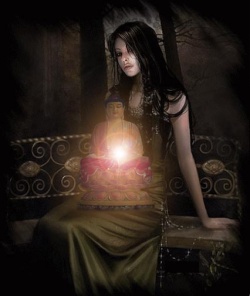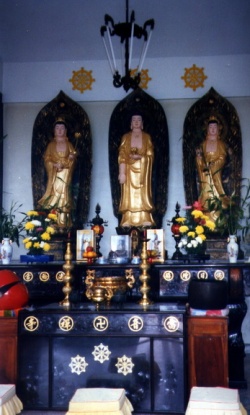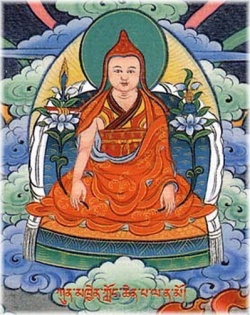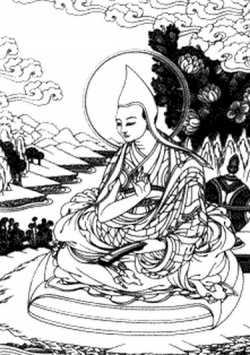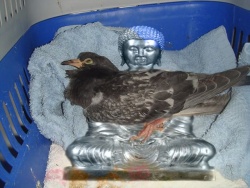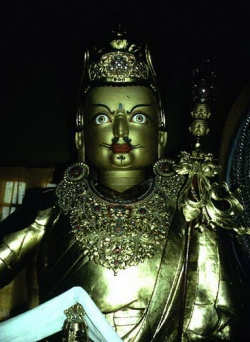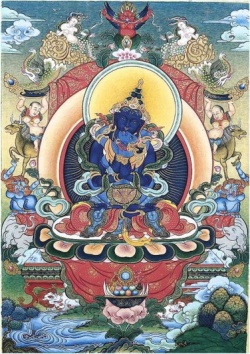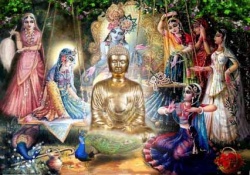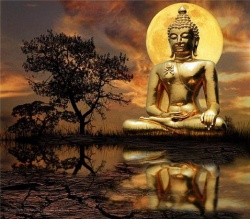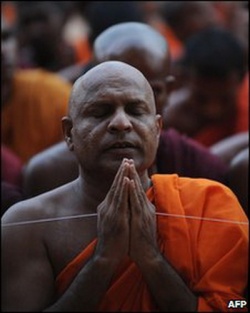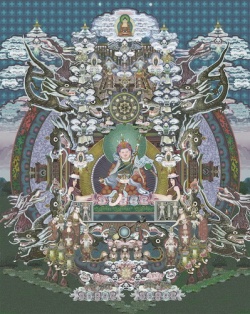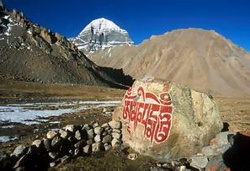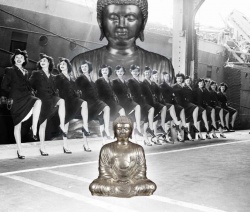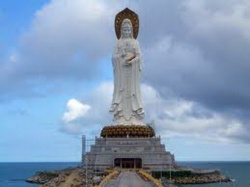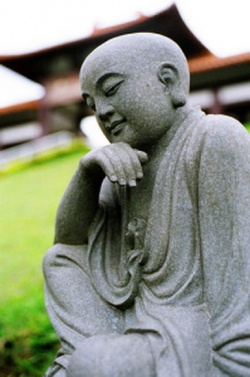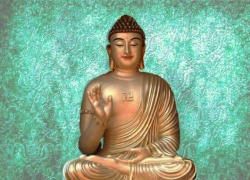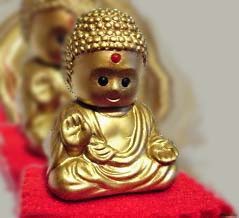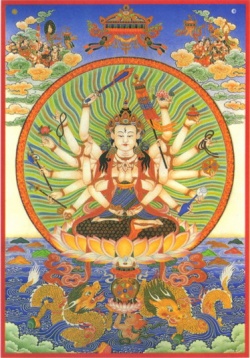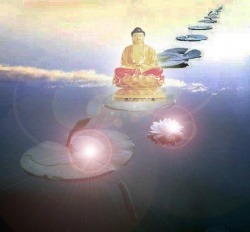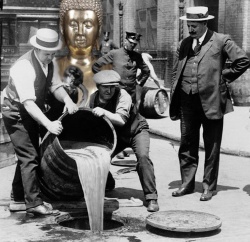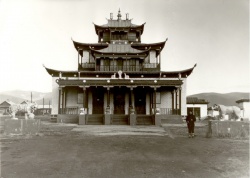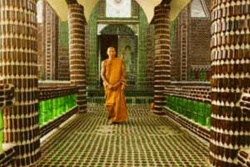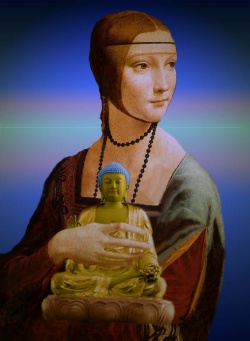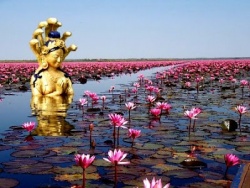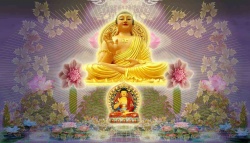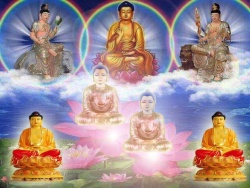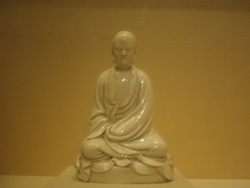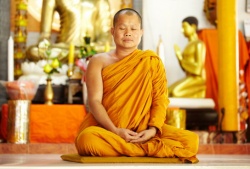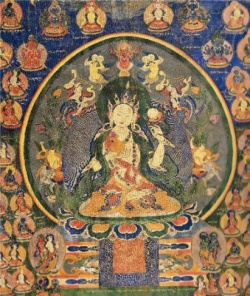Ancient Hindu Atomism
Indian Atomism and Quantum theory
by P. Priyadarshi
(From, Zero is Not the Only Story, 2007, P. Priyadarshi, India First Foundation, New Delhi.)
If we make a comparison between the ancient nations, the Indians came closest to modern ideas of atomism, quantum physics, and other current theories.[i] India developed very early, enduring atomist theories of matter.
It was not at all a stray speculative mention of atom, but a thoroughly discussed conclusion of the ancient Hindus (vide infra). Greek atomist thought was borrowed from India possibly via the Persian civilization.[ii]
Teresi says, “The Rig-Veda, dating somewhere between 2000 and 1500 B.C., is the first Indian literature to set down ideas resembling universal natural laws.”[iii]
Traditionally, the western authors have been reluctant to accept ancient Indian achievements in science and hence they hold that Democritus was writing physics but the same thing if written by an Indian was metaphysics.[iv]
This prejudice has been so high that Park sums up, “The Upanishads refer to an imaginary symbolic cosmos. Democritus was talking about the way things really are or (better) might be.
These are different worlds of discourse. They cannot be compared.” (See notes[v]).
Democritus used a naïve logic that you cannot go on cutting something forever and therefore there must be atoms at the end, which you cannot cut any further. On the other hand, the Indians gave a much better logic, “Take a mountain and a molehill, they said. Which has more particles? The mountain, obviously.
That means you cannot cut forever, that there is a finite, uncuttable particle.
If the particles were infinitesimal, the mountain and the molehill would have equal number of particles, and they would lose any real meaning—again, an assumption but, in a way, more hard minded than Democritus’s guess. And the Indians, unlike Democritus, displayed a rudimentary understanding of infinite sets.”[vi]
Moreover Indian atomism was older than the Greek atomism, because there is evidence that Pakudha Katyayana, an older contemporary of Buddha taught atomic theory much before the earliest Greek atomic theory.[vii]
The Greek philosopher Empedocles gave four elements, earth, air, fire and water in c. 460 B.C.[viii], much later than the five elements had been given in India and possibly he borrowed it from the Hindus through Iranian intermediaries. The Greeks transmitted these four elements to the Muslim world later. Moreover, the Greeks could never comprehend the fifth element space, which permeates everything and everywhere.
The ancient Indians described that universe is constituted of air, water and earth—the three components of matter–and energy and space.
The air, water and earth of the ancients were analogous to gas, liquid and solid of modern era.
The gas, liquid and solid matter plus energy were composed of indivisible particles or atoms in ancient Indian physics as they are in the modern physics.
The gas atom had the characteristic feature: motion.[ix] Modern science also subscribes to this fact that the characteristic feature of gas molecules is their kinetic motion, and the theory is called the kinetic theory of gases.
We know today that the solid and liquid molecules are bound together by intermolecular forces and cannot move freely, although, these also vibrate.
The ancient Indians thought of atoms of energy (light and heat) as well, which modern physicists term photon.[x]
They clearly said that space is not atomic.[xi] They said that the matter (air, water and earth) and energy took part in combination and compound formation whereas space did not.[xii] This is again a modern concept that energy was involved with matter in compound formation.
Consistent with modern physics, the Upanishads postulated that the first element was tejas (energy: fire, light) from which second element water and then earth originated.
(See notes[xiii]). Air and space were other two elements.
It was understood by the Vedic Hindus that light and heat and also sound are just different forms of the same thing–energy. Chandogya Upanishad says, “This is the light within the body of man.
This light can be seen in as much as one has the perception of warmth when one touches the body. And the same light is heard when you close your ears and hear some bellowing sounds.”[xiv]
The Samkhya system of 6th-5th century B.C. expanded more on the subject of elements and atoms. Samkhya system postulated that the universe is composed of inactive matter (Prakriti) and active principle energy (Purusha).
This is more like Newtonian physics. “Very modern and Western in its approach, the Samkhya asserted that matter could not come out of nothing but resulted from what was potentially present, that is, “the unmanifest becomes manifest”.[xv] They imagined two sets of elements, one subtle (tanmatra) and gross (mahabhuta).
The elements of the Samkhya system develop from the primeval substance (Prakriti) and are not eternal themselves.[xvi] Earth Water and Air may be viewed as comprising all the elements or compounds in the solid, liquid and gaseous states respectively.
According to Samkhya, the ultimate units called anu are made up of infra-atomic particles known as [[[tanmatra]]]]-s. It admits that the property of each of the pancha-bhutas vary with the grouping of tanmatras in the atoms of each. In modern terminology tanmatras can be equated with nucleons and probably electrons, variation of which causes change in the elements. It is surprising that the Samkhyas could propose something so modern about to 2000 years that.[xvii]
In the Jain atomic theory, matter is an eternal substance, consisting of atoms. Abhidharmakoshavyakhya and Tattvarthadhigama Sutra are the two Jain texts, which have gone into detail of the nature of matter.
Atoms are porous and hence matter may increase or decrease in volume without addition or loss of particles.[xviii] On the other hand the first modern atomist Dalton thought atoms to be solid and hard.[xix]
Under certain circumstances, material substances may coalesce into one substance and one substance may divide into many.
In modern terminology, elements may combine into compounds and compounds may break into constituent elements.[xx].
Anu was the term for a single atom and skandha was the term for combination for atoms (molecules).[xxi] The Jains believed that Anu is both cause and effect.
The various compounds (Skandhas) named by the Jainas are dvyanuka or dvipradesh, ananant Anu etc.
Every atom possesses an infra-sensible or potential taste, smell, and colour, and two infra-sensible tactile qualities-roughness or smoothness, dryness or moistness, hardness or softness, heaviness or lightness, heat or cold.
A skandha however, assesses in addition the following physical characteristics: sound, atomic linking, dimension, shape and configuration, divisibility, opacity, and radiant heat and light.[xxii]
Everything in this universe, except souls and space is produced from matter (pudgala).
All matter consists of atoms. The Jainist atom comes in two opposite kinds that are named snigdha (smooth or positive) and ruksha (rough or negative)—which combined, an idea that foreshadowed the modern concept of ionic (electrovalent) bonding.[xxiii]
The simplest molecules consisted of two atoms.[xxiv] Substances undergo modification while maintaining their primary nature.[xxv]
By the word anu, the Jainists probably also meant sub-atomic particles depending on the context. Hence the positive and negative could also mean protons and electrons.
Hence when the Jain physics says that anus have “spin”[xxvi], they are actually talking about a quality of particles not discovered until twentieth century.
The anu was a point in space (or field) and ephemeral in relation to time.[xxvii] We can appreciate that this character belongs more exactly to the subatomic particles and not to atom itself.
Each anu occupied one point (pradesh) of space. Thus this anu was both porous and a point as well.[xxviii] How can a point be porous?
But this type of seemingly absurd concepts are actually very much modern and in vogue in advanced particle physics. A 10-dimensional or 11-dimensional computer generated model of elementary particles looks very much porous.
Today’s elementary particles are point-like with zero radius and they create ‘fields’. In the West, the concept of field created by points in space was given by Boscovich in 1760 which was ignored at that time but later Michael Faraday built up his theory on the basis of ‘fields’ in the 19th century, and fields surrounding a point is now a very much common occurrence in modern physics.[xxix]
Dick Teresi writes, “The idea of (fundamental) particles being geometrical points with no dimension is very Indian, and is still counterintuitive to us today.”[xxx]
While the Indians were able to comprehend space as a field of emptiness (see shunya in mathematics section) with coordinates in three axes[xxxi] many thousand years ago, the European scientists could never grasp such an idea and continued to talk about ether, a thin substance filling space until Albert Michelson was awarded Nobel Prize in physics for casting doubts on existence of ether in 1907.
James Clark Maxwell, highly accomplished physicist of the nineteenth century subscribed to ether as well as Newton and all other physicists before 1907. Many physicists in the West continued to hold on to ether even after 1907 until Einstein finally rejected it.[xxxii]
The Jain model of atoms vibrated. It was said that different types of atoms took up vibrations with different intensities.[xxxiii] This again goes well with the modern concepts in physics.
Not only are atomic and sub-atomic particles constantly vibrating themselves, but also the atoms do release distinctive vibrations in space in the form of waves.[xxxiv]
The earlier Buddhist philosophies, the Vaibhasika and the Sautantrika schools did believe in atoms (although the later schools like Madhyamika (Mahayana) did not).
The Buddhist atom was seen as transitory, continually going through phase changes[xxxv] and thus was somewhat like quantum of Plank.[xxxvi] Science historian D.M. Bose says, the Buddhist atom was more of a force or energy present in all matter—that is an earthly matter-force of repulsion.
They added to it that all existence is momentary and stable matter is an illusion.[xxxvii]
B.V. Subbarayappa writes, “What is ultimately real is instantaneous being.
As things have momentary existence, i.e., they disappear as soon as they appear, the Buddhists do not consider motion with reference to matter at all.
But as Shantirakshita says, “The essence of reality is motion. Reality is indeed kinetic…the interdependence of moments following one another, evokes the illusion of stability of duration, but they are forces…flashing into existence without enduring any substance.”[xxxviii]
It is more likely that the Buddhists referred to sub-atomic or elementary particles as anu, and in that case, the description of anu fits well in the description of elementary particles of the quantum mechanics of Max Plank.
Thus some Buddhists conceived of the elementary particles not only as the minutest object capable of existing in space or field, but also as occupying the minutest possible duration of time.[xxxix]
Mahayana doctrine of emptiness (shunyata) assumed that true void was foundation of all existence. Everything comes out from void and ultimately returns to void.
In Madhyamika School, reality is like a swatch of cloth, which appears solid from a distance but on close inspection is found to be just a loose assembly of threads.[xl] Modern science also says the same thing.
The solid structures surrounding us are in fact hollow, mostly empty space, interaction of particles in constant violent motion providing the illusion of stability and solidity.
This all is consistent with what modern particle physicists have spoken in the last thirty years.
Analogous to the modern electrical and magnetic fields, the Indians conceived of an all-pervading field of space, the etheric field, and infinite in extent. This has been studied in detail by John Maxson Stillman.[xli]
The Samkhya-Patanjala view thought of two modes of Akasha, one karanakasha was conceived of being a universal medium (avakasha), whereas the grid-like atomic karyakasha was a derivative of the other akasha, and had the potential to vibrate.[xlii]
This is very much in consistence with the latest grid-theory of space.
The Vedanta philosophy also conceived of the same duality in akasha and named the atomic-space as vayuram kham and the non-atomic motionless, ubiquitous, primordial matter rudiment as puranam kham.[xliii]
This again is very much consistent with the latest researches, which indicate that particles (matter) may be continuously originating out of mother-space (or void).
Among the orthodox Indian schools, the Vaisheshika and Nyaya went at length discussing issues of physics and physical chemistry. Badarayana regarded atomism as the cardinal feature of the Vaisheshika system.[xliv]
The Vaisheshika and Nyaya Sutras and the Nyaya Bhashya by Vatsyayana and the Prashastapada Bhashya of the Vaisheshika system are some of the texts, which discuss these topics in detail.
In about 600 B.C., Kanada, the proponent of the Vaisheshika school of thought after applying his logic concluded that light and heat are two forms of the same substance.
Similar relationships were made earlier also between heat, light and sound in the Upanishads (vide supra).
Kanada said, “Light is coloured, and illumines other substances; and to the feel is hot: which is its distinguishing quality. It is defined as a substance hot to feel.” Heat of hot water is felt but not seen and moonshine is seen but not felt.
Basing his reasoning on the sensory qualities of light, Kanada claimed that light existed both in an actual and a potential state.[xlv]
When wood is burnt, the potential state light, stored in wood is released by the act of burning. Fire was a process that released the stored light (energy) from material atoms.
It was assumed that there was a bodily fire (jathara-agni) in human beings which could release energy from the foodstuff we eat.
We know today that light photons can stay as photons absorbed by electrons in an atomic orbital, storing potential energy. Thus what the ancient Indians said thousands of years ago, is being retold by modern science.
Kanada also claimed that light has a particle (light atom) nature and a holistic (wave) nature.
“Light is eternal, as atoms; not so as aggregates.” This statement reflected the whole-part duality of the Nyaya-Vaisheshika school.
It meant that in the subtle form, light would be size-less and eternal wave, whereas in gross form, it would be temporary as quantized particles.[xlvi]
Kanada further said, “The mote, which is seen in a sun beam, is the smallest perceptible quantity.
Being a substance and an effect, it must be composed of what is less than itself; and this likewise is a substance and an effect; for the component part of a substance that has magnitude must be an effect.
This again must be composed of what is smaller; and that smaller thing is an atom.”[xlvii]
Here we come across a hypothesis that mass is an effect of the fundamental particles and not a feature of them.
This is something a very latest concept and is being thought on these days by the physicists working on relativity, unified-field-theory and super-strings etc.
Regarding atoms, Kanada reasons, “Things that exist and are not produced from a cause are eternal; they may be inferred from the fact that all known things are productsy.
Besides, as we call we call everything we perceive non-eternal, this idea of non-eternity presupposes eternity.”[xlviii]
“And finally the fact that we do not perceive the ultimate, i.e. uncaused cause of things, constitutes our ignorance, and thus we are forced to assume that these ultimate causes are eternal.”[xlix]
It has been said by interpretation of the last quoted that, “as we can imagine no other cause of the destruction of a thing than the disjunction or destruction of its cause, it follows that the last causes must be eternal…
It is to be understood that these eternal things, the causes of the non-eternal ones, are the atoms;
but they are not visible.”[l] The sutra declares that a thing may be visible if it has many constituent parts and possess color.[li]
Next sutra states that atom is invisible because it is not composed of any material parts.[lii] This statement is again a great leap and a very modern concept that the fundamental ingredients of atom (and matter) are non-material.
A thing can be great if it has many constituent parts or the parts are themselves large or if the parts are arranged in a particular way. In any way, the greatness of anything implies it’s being composed of parts.
The reverse of this would mean that anu being small, is without parts.[liii] Next Sutras (10-20) define the concept of small (sukshma) and great or gross (mahat, sthula).
The terms ‘small’ and ‘great’ refer to a distinct kinds or genera of dimension and not size of the thing under consideration.[liv]
It may be just a coincidence that the modern particle physics has defined a 10-dimensional universe in which four dimensions of space-time are unfolded or gross, whereas six dimensions remain wound up in points.
We also have the Nyaya Sutra of Gautam and Bhashya (commentary) on it by Vatsyayana (5th century A.D.). The Naiyayikas tried to find more truths about atoms with the help of logic in the same way as modern particle physicists do today. What they arrived at is applicable to sub-atomic particles more than atom themselves. For example they said,
“A thing consisting of parts is called a whole, but each part again must be considered as a whole, and so the parts of parts and so on ad infinitum. If we never could come to the last parts, we could not conceive the idea of the whole, and the whole would be dissolved into nothing. But the division reaches its limit in the atom, which cannot be divided any further, as we assume it to be absolutely small.
If the division into parts had no limits, the mote would not differ in size from the highest mountain, because both would have the same number of parts. (iv.2.1f)
Akasha as the Vaisheshikas assert, is a simple all-pervading, and infinite substance:
The question is put by opponents whether it penetrates the atom or not. If it does, the atom must have parts; if it does not, the akaska would not be all-pervading.
The reply is that the atom has no exterior or interior, nor is it hollow inside, but is a simple , not compound thing.
It is further objected that since atom has a form being globular, and the form of a thing consists in disposition of its parts, the atom must have parts.
And again, when three atoms are in juxtaposition, that in the middle touches the left on its right side, and that on the right on its left side; and when the atom is surrounded on all sides, we can distinguish six sides of the atom which must be considered its parts.
And if the six sides of an atom were reduced to one (i.e. if the atoms were a mere point,) then the aggregate of all the (mentioned) seven atoms would not require more space than one atom, and consequently a jar could be reduced to the size of an atom, and hence become invisible.
These arguments are met by the declaration that the division of atoms into parts is not real, but a mode of expression only.”[lv]
At certain places in the Nyaya-Vaisheshika texts, there is mention of ‘abhava” (absence) substance, which when unites with any other substance (all other substances are bhava), then there is moksha of the matter (annihilation, resulting in freedom from cosmic cycle of being in the Universe). This sounds very much like modern concept of anti-matter.[lvi]
The above-mentioned achievements of ancient Indians in the field of physics and physical chemistry may sound meager if we do not take into account what the modern European scientists thought of elements and atom etc till 17th century.
Till Lavoisier’s (A.D.1743-1794) discovery that water was not an element but hydrogen and oxygen combined to give water, all the Western scientists believed that there were only four elements, viz. earth, air, water and fire.[lvii]
Unlike the ancient Indians, the 17th century scientists did not recognize chemical bonding and thought that when one substance was formed from the other, one element just changed into the other.
Thus the famous physicist Robert Boyle believed that where plants grew with water only and no soil, it was water, which changed into earth.[lviii]
Indian’s never had such naïve beliefs and they always asserted that one element could not change into any other element (vide supra).
If we compare the ancient Indian atomic theory with the first modern Western atomic theory of Dalton, Dalton’s will stand much inferior and primitive compared to Indians.
He believed that atoms are tiny solid corpuscles.
The Vedanta school also had something to say. Shankara compared the atomic theories of various orthodox as well as non-orthodox schools in his commentary on the Vedanta Sutra.
The sum total of everything in the universe was called the parabrahman. On the other hand, simply Brahman meant the ultimate ingredient, which constitutes everything[lix]—matter, energy, and space—something like super-string of M-Theory of contemporary physics.
Hiranyagarbha, also called apara-brahman, is the active star material in the centre of Sun, which is in the form of a primordial plasma mostly consisting of hydrogen ions and is capable of giving birth to other matter (elements) and energy.
Brahman: The ancient Indian equivalent of Superstring of the M-Theory:-
Brahman was the reality (actually existing substance) of space, matter and energy.
It was the material or substantial cause of everything existing. In that way it was ancient Indian model of a theory for everything, latest of which is called the ‘superstring’.
Shankara, after thoroughly analyzing the scriptures wrote in his commentary on the Brahma-Sutra:
“Brahma-Sutra 1.4.23
Brahman is the material cause also, (on account of this view alone) not being contradictory to the proposition and the illustration (cited in the shruti).
Commentary: …Brahman is also the material (upadana, ingradient) cause of the world.
Here ‘also’ shows that it is the efficient cause as well.
It is only if Brahman is the material cause of the world that it is possible to know everything through the knowledge of Brahman, as texts like “By which that which is not heard becomes heard” etc. (Chandogya Upanishad, 6.1.3) say;…
The illustration referred to are: “My dear, as by one lump of clay all that is made of clay is known” etc. (Ch. 6.1.4).
These texts clearly show that Brahman is the material cause of the world; otherwise they would be meaningless. Again texts like “Brahman alone was at the beginning one without a second” shows that it is also the efficient cause, for who else could be such a cause when there was nothing else?
Brahma-Sutra 1.4.24
Also on account of the statement of will (to create on the part of the supreme self, it is the material cause).
Commentary:… ‘May I be many’ intimates that Brahman itself became many. Hence it is the material cause as well.
Brahma-Sutra 1.4.25
And because the Shruti states that both (the creation and the dissolution of the world) (have Brahman as) the direct cause.
Commentary: That from which a thing springs and into which it is re-absorbed is its material cause. “All these things spring from akasha (Brahman) alone and return to akasha (Ch. U. 1.9.1), “ That from which these things are produced, by which, when produced, they live, and into which they enter at their dissolution—try to know that. That is Brahman” (Tai. 3.1.).
These texts show that Brahman is the material cause also. A thing may be said to be produced from its efficient cause, but it cannot return to that at dissolution unless it is also the material cause.
Brahma-Sutra 1.4.26 : (Brahman is the material cause of the world) because (the Shruti says that) it created itself by undergoing modification…”[lx]
There is a long run of arguments in the commentary, which ultimately proves that the Brahman is the material cause or ingredient from which the universe is made of.
This is indeed the string of the M-Theory, which is the ultimate building block of everything in the universe, in a sense both ingredient as well as efficient cause of the universe.
Shankara’s explanation of the world as evolved by apparent modification of Brahman into the phenomenal world is also called the Vivertavada.[lxi]
Further, Shankara rejected the Vaisheshika view that at the time of cosmic dissolution, everything returns to atomic state in which they stay till new cycle of evolution starts.
Shankara asserts that the atoms also dissolve into a final un-differentiated state of Brahman.
This opinion sound more correct than that of the Vaisheshika’s, in view of modern concept of origin and dissolution of matter.
In the Vedanta school of Hindu thought, the things in the world are jada or inert, meaning they cannot move without application of external force. Jadatva means inertia.
On the other hand Brahman is chaitanya or active. This activity, chaitanya, is not because of any external force. Chaitanya means spontaneous activity without any external force. Anything which moves because of external force is not chetana but is actually jada.
Light has been considered a state of Chaitanya. (see notes[lxii]) But the actually spontaneously active with rhythmic movement is the super-string. In more scientific words, it can be said that the universe is composed of super-strings (Brahman), which is constantly spontaneously active in a rhythmic musical vibration and the things composed by these super-strings (Brahman) are not capable of spontaneous activity and therefore possess inertia.
The definition of Brahman as sat-chit-ananda also means the same thing (see notes[lxiii]).
It is quite incredible that the features of the brahmastra described in ancient Hindu scriptures are more of less that of the nuclear bombs. It had the capacity to destroy the whole world.
A brahmastra could even damage fetuses, as in the case of Abhimanyu’s wife Uttara, and after the explosion, its exploder Ashvatthama suffered an incurable skin burn like disease.
This feature again strongly suggests identity with the nuclear bomb. If we identify Brahman with primary substance plasma or basic building block ‘string’, there can remain no doubt that brahmastra, whether imaginary or real, was the nuclear bomb.
Another concept of Shankara’s Advaita theory (monism) is maya or illusion. Maya actually is the deficiency in the sense organs and mind of man because of which he can never perceive real form of anything. Human perception is not perfect enough to perceive exactly how matter exists.
This concept is also quite modern.
We know today that there is hardly anything which human beings can perceive correctly.
One example is matter, which is hollow (as model of atom shows), but we see it as solid. Maya operates on reality (Brahman) in such a way that things cannot be perceived as they actually are.
The maya has been compared to the Higgs field of modern physics. Dick Teresi has summarized it thus, the maya “gives illusory weight to the universe.
In this and other ways, the maya is similar to the Higgs field, an all-pervasive, invisible field that fills the universe like ether, or so some particle physicists propose.
They are confused by the various weights of particles in standard model. There seems to be no formula that generates these masses.
In fact, why should mass exist at all? A possible solution is the Higgs field, which imparts more weight to some particles than others, making them appear heavy.
The particle responsible for this field, the Higgs boson, is still being sought in accelerator laboratories today.”[lxiv]
Hiranyagarbha is another term that comes in the Vedic literature frequently. Literally, hiranya means gold or golden.
Garbha means ‘centre of’.
Hence hiranyagarbha means ‘the centre of the golden structure’—the central part of the spherical sun.
Whenever Hiranyagarbha is mentioned in the Upanishad texts, it stands for the active principle inside the sun.
Modern science has discovered that interior of sun is made up of plasma, mainly consisting of hydrogen ions or protons with freely floating electrons, and from this plasma, continuously, other elemental atoms and energy are being generated by the process of nuclear fusion.
Plasma was the first form of matter initially, from which all other matter was formed or created.
This modern and scientific statement of fact is already stated in the Rig-Veda, “First of all, Hiranyagarbha (plasma) was formed and from this everything else in the creation was created.”[lxv] Another mantra says, “Hiranyagarbha (inside of sun, plasma) gives vital air and energy.”[lxvi]
It may not be just a coincidence that sun continuously gives out energy (light and heat) as well as a solar wind.
Similarly, Brihadaranyaka Upanishad says, “The essence of that form which is gross, mortal and limited is the shining sun, for it is the essence of those three elements.”[lxvii]
While referring to the Sun, Isha Upanishad says that the face of reality is covered by golden lid[lxviii].
The Mundaka Upanishad says, the Brahman is within the golden cover; free from modifications (viraja), without any parts (nishkalam) and pure.[lxix]
Here also the word Brahman stands for a primordial state of matter, the first stage before formation of solid , liquid or gas—the plasma stage.
Hiranyagarbha is central to the Upanishadic philosophy because it is the original form of matter existing even now, from which different forms of matter as well as energy are still being formed, every moment.
Again, in the Mundaka Upanishad we find, “From Him emerges the fire of which the fuel is the sun.”
Here we find the mention of a special type of fire, which is consuming sun as fuel. This we know today is the nuclear fire.
We find a very relativitistic and modern concept written by Uddyotakara which was also supported by Shridhara that the gravity as a whole of a body composed of particles is not the same as the sum of gravities of the particles; there is a difference in amount which is, however, so small as to be imperceptible.[lxx]
Prashashtapada in his chapter on time analyses time as an ingredient of universe.[lxxi] Atharva Veda also gives a good analysis of time.
y This is in contrast to the three Semitic religions, which claim many things have been created by God. In that case, those things cannot be said to be product of other substances because they emerge directly from God.
[i] Teresi, Dick, Lost Discoveries, Simon and Schuster, New York, 2002. p. 210.
[ii] Bose, D.M., Sen, S.N., and Subbarayappa, B.V. (Eds.); A Concise History of Science in India, Indian National Science Academy, New Dehi, 1971. p. 448.
[iii] Teresi, op. cit., p. 210.
[iv] Teresi, p. 211.
[v] Park wrote this in a letter to Dick Teresi in 2001. Teresi replies to this in the following words, “On the other hand, neither the ancient Indians nor Democritus derived their ideas from experiments, and in that sense, we could dismiss both as philosophy rather than science. Or we could be more catholic and accept that two different ancient cultures came to similar conclusions about the world.” ( Teresi, p. 211.)
[vi] Teresi, p. 211-12.
[vii] Basham, A.L.; The Wonder that was India, Part I, Rupa & Co., Bombay, 1999. p. 497.
[viii] Teresi, p. 212.
[ix] Jacobi, H.; Atomic Theory in Indian Thought, (First published in Encyclopaedia of Religion and ethics, ed. Hastings, J. and T.T. Clark, Edinburgh, 1908. Vol. Ii, pp. 199-202). Reprinted in ‘Studies in the History of Science in India’, Vol. I, Ed. Chattopadhyaya, Debiprasad; Asha Jyoti, New Delhi, 1992. p. 30.
[x] Jacobi, p. 30; and Basham, p. 497.
[xi] Jacobi, p. 30; and Basham, p. 497.
[xii] Jacobi, p. 26.
[xiii] Chandogya Upanishad, 6.2.3-4. By now we know that energy condenses to form fundamental particles which lead to formation of hydrogen atom which later gives origin to other material substances. Hydrogen has been often referred to as water in ancient Indian cosmological vocabulary.
[xiv] Chandogya Upanishad, 3.13.7.
[xv] Teresi, p. 212.
[xvi] Jacobi, op. cit., p. 26.
[xvii] Vyasa, Yoga-Bhashya, II.19; IV.14; Also see Vijnanabhikshu, Samkhya-pravachana-bhashya, I.62 and Yoga-vartika, III.40. Referred by Ray, Priyadaranjana, Chemistry in Ancient and Medieval India, in The Cultural Heritage of India, Vol. VI, op. cit., p. 138.
[xviii] Jain, N.L., ‘Chemical Theories of the Jains’, in Henry M. Leicester (Ed.), Chymia: Annual Studies in the History of Chemistry, University of Pennsylvania Press, Philadelphia, 1966. 11:13. p. 14-16.
[xix] Hill and Kolb, Chemistry for Changing Times, p. 48.
[xx] Jaicobi, H.; Atomic Theory in Indian Thought, Encyclopaedia of Religion and Ethics, Ed. Hastings, J., Clark, T.T., Edinburgh, 1908. Vol ii, pp. 199-202. Reprinted in ‘Studies in the History of Science in India’, Vol. 1, Ed. Chattopadhyaya, Debiprasad; Asha Jyoti, New Delhi, 1992. p. 24.
[xxi] Jain, N.L., ‘Chemical Theories of the Jains’, in Henry M. Leicester (Ed.), Chymia: Annual Studies in the History of Chemistry, University of Pennsylvania Press, Philadelphia, 1966. 11:13. p. 11-13.
[xxii] Ray, Priyadaranjan, Chemistry in Ancient and Medieval India, in The Cultural Heritage of India, Vol. VI, The Ramakrishna Mission Institute of Culture, Kolkata, 1986. p. 141.
[xxiii] Teresi, p. 215.
[xxiv] Jain, Chemical Theories of Jains, pp. 16-17. (Referred by Teresi, p. 216.)
[xxv] Teresi, p. 214.
[xxvi] Teresi, p. 309.
[xxvii] Bose, Sen and Subbarappa (Eds.), A Concise History of Science in India, pp.466-7.
[xxviii] Teresi, p. 214-15.
[xxix] Teresi, p. 215.
[xxx] Teresi, p. 215.
[xxxi] Vachaspati Mishra discusses about how location of a point in space can be described by the three axes. Described by Seal, B.N.; The Positive Sciences of the Ancient Hindus, Delhi, 1958. p. 129.
[xxxii] Teresi, p. 310.
[xxxiii] Bose, Sen and Subbarappa (Eds.), A Concise History of Science in India, p. 467.
[xxxiv] Teresi, op. cit., p. 215-16.
[xxxv] Bose, Sen and Subbarappa (Eds.), A Concise History of Science in India, p. 468-9.
[xxxvi] Basham, A.L., op. cit., p. 497.
[xxxvii] Teresi, p. 216.
[xxxviii] Bose, Sen and Subbarayappa (Eds.); A Concise History of Science in India, p. 469.
[xxxix] Basham, A.L.; The Wonder that was India, Rupa & Co., New Delhi. 1999. p. 497.
[xl] Teresi, p. 217.
[xli] Stillman, The Story of Alchemy, pp. 105-111.
[xlii] Vijnanabhikshu, Yoga-vartika, III.40.
[xliii] Seal, B.; The Positive Sciences of the Ancient Hindus, Motilal Banarsidass, Delhi, 1958. p. 121.
[xliv] Vedanta-sutra ii.2.11 ff, and Shankara’s remarks on ii.2.1.
[xlv] Ray, P.C.; ‘A History of Hindu Chemistry from the Earliest Times to the Middle of Sixteenth Century A.D.’, Williams and Norgate, London, 1902-09. 1: p.7-9.
[xlvi] Ray, P.C., op. cit., p.7,8.
[xlvii] Teresi, p. 218.
[xlviii] Vaisheshika Sutra, iv.1.1-4.
[xlix] Vaisheshika Sutra, iv.1.5.
[l] Jacobi, p. 27.
[li] Vaisheshika Sutra, iv.1.6.
[lii] Vaisheshika Sutra, iv.1.7. Not available in many texts, but quoted in the Nyaya Vartika. Referred to by Jacobi, p. 27.
[liii] Vaisheshika Sutra, vii, 1.9, not available in texts but quoted by Shankara in Shankara Bhashya of the Vedanta Sutra, ii.2.11).
[liv] Jacobi, p. 27.
[lv] Jacobi, p. 29-30.
[lvi] “Tadabhave samyogabhvopradurbhavashcha mokshah.”Vaisheshika darshanam, 5.2.18; also see Vardhaman nyaya-lilavati-prakasha, p.17, Chaukhambha. Nyayalilavati, p. 16 and Nyayavartika p. 11.
[lvii] Teresi, op. cit., p. 280.
[lviii] Teresi, p. 279.
[lix] “Sarvam brahmaupanishadam”, Shanti-Patha in the beginning of the Chandogya Upanishad.
Also, “Sarva khalvidam brahma”, Chandogya Upanishad, 3.14.1.
[lx] Brahma Sutra : Text, translation and comments according to Sri Sankara; Tr. by Swami Vireswarananda, Advaita Ashrama, Calcutta, 1982. pp.137-141.
[lxi] Swami Vireshwarananda, Brahma Sutra, op. cit.. p.3 of Adhyasa.
[lxii] Today, unfortunately chaitanya is translated as intelligence or consciousness by many authors, which is wrong. After the fall of tradition of science in India, the words chit and chaitanya became associated with mind because of the so-called fast speed of mind. But earlier analysis by the more ancients had indicated that mind is in fact jada or inert. Hence it cannot be associated with chaitanya or spontaneous activity. Consciousness and intelligence being properties of mind are inapplicable to any other thing. Hence use of word intelligence or consciousness to mean chaitanya is wrong.
[lxiii] The Brahman has been called Sat-chit-ananda. Sat means existence, which is eternal. Cit stands for spontaneous activity, and ananada represents the musical vibration. Hence the phrase sat-chit-ananda means eternal existence with spontaneous rhythmic movement, which is in fact the characteristic feature of the ‘string’. –Author.
[lxiv] Teresi, p. 213.
[lxv] Rig Veda, 10.121.1; 10.72 and 10.190.
[lxvi] Rig Veda, 1.121.2 (Griffith translation).
[lxvii] Brihadaranyaka Upanishad, 2.3.2.
[lxix] Mundaka Upanishad, 2.2.9.
[lxx] Chatterjee, S.D. , “Physics and Mechanics in Ancient and Medieval India” in the Cultural Heritage of India, Vol. VI., p. 104.
[lxxi] Kalaprakarana in the Prashastapada Bhashyam, Hindi Tr. by Dhundhiraj Shashtri, Chaukhamba Sanskrit Sansthan, Varanasi, 2002. pp. 41-44 (sec.2).
Source
https://scientificspiritualism.wordpress.com/2013/03/15/ancient-hindu-atomism/


